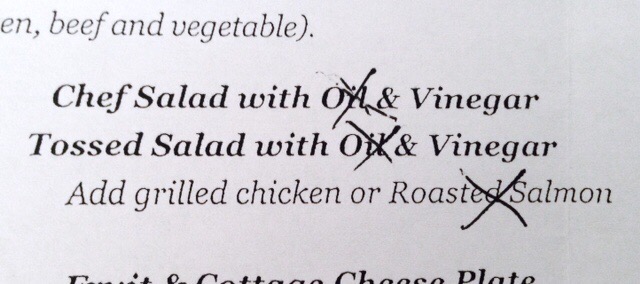Hospital food is notoriously bad and unhealthy. I remember being in hospital in North Georgia in 2007 and the choices were all deep-fried or heavily sweetened.
Tom and I eat pretty healthy food, especially in the last three years. We avoid sugar and processed foods, we eat whole foods, fresh vegetables and fruits, we go easy on the grains and don’t eat wheat.
So when we arrived at University Hospitals on Thursday night, I was pleased to see a gluten-free menu that offered salad and roasted salmon. Since Tom’s stroke was caused by high blood pressure and he also has the risk factors of high cholesterol and diabetes, his diet will be important in avoiding another stroke.
To order food for Tom, I call down and give his name and room number. This information is tied to his dietary restrictions in the kitchen’s ordering software. So if I try to order something that he can’t have, such as fried foods, the attendant tells me, “Sorry, that’s grayed out.”
It’s meant to keep patients on their diet without needing to have every meal reviewed by a dietician.
Good concept. Poor execution.
The first problem was that we don’t eat wheat. Neither of us is allergic, we just gave up wheat three years ago and never looked back. Unfortunately, once that preference was entered in the system, we could ONLY order off the gluten-free menu.
This is to protect people who have celiac disease; if they ingest even a crumb of wheat they can have a severe reaction. For us, this isn’t the situation; it’s just a dietary preference. We can have small amounts of wheat flour without problems.
But having been labeled “gluten-free,” Tom couldn’t just say, “Never mind.” It would take a doctor’s order to remove the gluten-free restriction.
The next problem was that the gluten-free menu had been changed recently, but the kitchen is still distributing the old menu.
So I tried to order tuna salad, and was told, “We don’t have that on the gluten-free menu.” I said, “I’m looking right at it on the printed menu.” I was told, “Oh, you must have an old menu. We’ll send up a new one.”
The new menu was identical to the old one. Including the tuna salad.
The third problem was that someone on Tom’s medical team had ordered a low-fat diet. This means no more than 10 grams of fat per meal.
The addition of this restriction ruled out more than half the items on the gluten-free menu.
On top of all this, there are often 10- to 20-minute hold times to reach an attendant on the phone, and then the ordering process can take another 15 minutes because of these problems with the system.
Today I tried to order Tom a salad with low-fat dressing and roasted salmon.
“He can’t have that,” I was told.
What diet in the world would rule out salmon and salad? Especially someone who really needs fresh green vegetables and the Omega 3 fats in salmon?
I asked the attendant why he couldn’t have those. “I don’t know why, it’s just grayed out,” she said. I speculated that it would be the oil and vinegar hitting the fat limit, and asked for low-fat dressing. Still wouldn’t go through.
I asked what wasn’t grayed out.
Among the choices: a hamburger, ziti pasta, cheese pizza, whipped potatoes, and chicken fingers. Oh, and pudding. All gluten-free, and not individually exceeding 10 grams of fat, therefore “healthy” for Tom.
So: Under this automated system, Tom could have chicken fingers, potatoes and chocolate pudding – but NOT salmon and salad.
The attendant could understand my amazement at this. But she couldn’t override the system.
I ordered chicken fingers with steamed rice and carrots, and a fruit cup. And chocolate pudding. The order sailed right through.
When I told the nurses about this, they were amazed and irritated. Today they have badgered the doctors to change the orders, so as of tomorrow Tom is supposed to be eligible for the regular menu, with the only restriction being “diabetic.”
Maybe then he can get a salad.
Today’s penny is a 2013, the year we dropped wheat from our diet.

Egads! Does the hospital have soda machines in the hallways? That is my pet peeve. They offer up the very thing that creates the health problems they are treating.
That story is unbelievable. Yet appallingly believable. I’m hope it’s all sorted now!